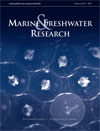Marine and Freshwater Research
Volume 64
Number 1 2013
Global warming has and continues to warm the ocean, which may have detrimental effects on marine wildlife. We have shown that at projected sea-surface temperatures, sea urchin sperm longevity is significantly reduced. This may have significant consequences for future sea urchin population dynamics.
Populations or races of fish may be distinguished by elemental composition of the earbone or otolith. The otolith chemistry of three populations of a coastal fish was consistently altered by the effect of a common, blood-feeding, isopod ectoparasite. Differential rates of infection – and by parasites not as conspicuous as an ectoparasite - may be an important but unappreciated factor driving stock- or population-based differences in otolith chemistry.
Population metrics, movement patterns and fishery dynamics are key components to our understanding of the vulnerability of carcharhinids to human processes. We integrated new and published data within a fuzzy-logic model system to show that the bronze whaler Carchahinus brachyurus ranked in the mid to lower end of the vulnerability spectrum, when compared with six sympatric pelagic shark species that inhabit coastal and shelf waters of southern Australia. Our findings emphasised a need for improvement to management measures for C. brachyurus and C. obscurus.
Understanding the reasons and cues for migration is critical to effective fish conservation and management. This study demonstrates the existence of a downstream spawning migration by the threatened Australian grayling and the importance of river flow as a migration cue. The results serve to highlight the potential impact of barriers to movement and changes to river flows on Australian grayling reproduction in coastal rivers in south-eastern Australia.
Understanding the life-history attributes of aquatic species under continual and increasing pressure from water-resource development is integral to the development of environmental-flow strategies. We investigated the water temperature and flow requirements for spawning of the Fitzroy River golden perch (Macquaria ambigua oriens) and found spawning was associated with the peak and/or recession of the first or second post-winter flow event where water temperatures exceeded 24°C. The interaction of spawning flows with existing and future water-resource development must be considered to ensure maintenance of the population viability of M. ambigua oriens.
The life histories of small-bodied coastal sharks are generally less conservative than large-bodied species. The present study aimed to describe, for the first time, the detailed life history of the small-bodied slit-eye shark, Loxodon macrorhinus. In comparison to other coastal sharks, the biology of the species conforms to that of other small-bodied species, with its apparent fast growth and early maturation contrasting that of large-bodied species.
Coastal saltmarsh is a sentinel ecological community, vulnerable to decline in extent and condition as a result global climate change. This paper reviews the geomorphology, biogeography and ecology of Australian saltmarsh in global context, and explores the actual and potential impacts of enhanced atmospheric CO2, temperature rise, sea-level rise and other climatic and hydrological changes. Of these stressors, sea-level rise is likely to have the greatest impact over the coming century, and facilitated retreat of saltmarsh will be required if the substantial ecological goods and services provided by this community are to be maintained.
Reproductive rates and abundance of market squid were estimated from fishery data collected from three major spawning grounds off California (1999–2006). Abundance estimates were consistently higher in southern than in northern California waters. In most quarters, reproductive outputs were above the current management threshold and ultimately, deemed appropriate for maintaining a sustainable population over the long-term.




